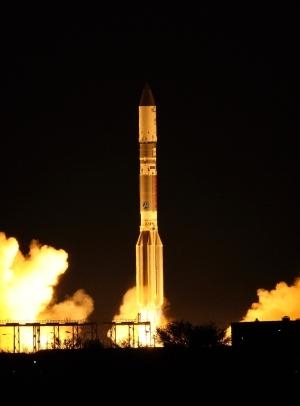Tue, Oct 29, 2013
Sirius FM-6 Boosted Into Orbit From Baikonur Cosmodrome
International Launch Services (ILS) successfully carried the Sirius FM-6 satellite, built by SSL, into orbit today on an ILS Proton for Sirius XM Radio Inc.

The ILS Proton Breeze M vehicle launched from Pad 39 at the Baikonur Cosmodrome at 1409 EDT October 25. The first three stages of the Proton used a standard ascent profile to place the orbital unit (Breeze M upper stage and the Sirius FM-6 satellite) into a sub-orbital trajectory. From this point in the mission, the Breeze M performed planned mission maneuvers to advance the orbital unit first to a circular parking orbit, then to an intermediate orbit, followed by a transfer orbit, and finally to a geostationary transfer orbit. Separation of the Sirius FM-6 satellite occurred approximately 9 hours and 11 minutes after liftoff. The satellite, weighing over 6 metric tons, was built on the flight-proven SSL 1300 platform. This was the 6th satellite launched by ILS Proton for SiriusXM and the 27th SSL 1300 satellite launched.
Sirius FM-6 has an X-band uplink transponder and an S-band downlink transponder to deliver digital audio radio service. With approximately 20 Kw end-of-life power and an anticipated service life of 15 years, the Sirius FM-6 satellite is one of the most powerful satellites built today. The final orbital location for the satellite will be 116.15 degrees west longitude.
This was the 390th launch for Proton since its maiden flight in 1965 and the 83rd ILS Proton Launch overall. The Proton Breeze M vehicle is developed and built by Khrunichev Research and Production Space Center of Moscow, Russia’s premier space industry manufacturer and majority shareholder in ILS.
Phil Slack, president of ILS commented, “For over a decade, SiriusXM has entrusted ILS Proton to deliver their satellites into orbit. It is a tremendous honor for ILS to have been a part of the satellite radio industry since 2000, with the launch of SiriusXM’s first generation fleet on ILS Proton within a 5 month period. Thank you to all of the teams that made this successful launch possible, including SiriusXM, SSL, Khrunichev, and ILS.”
(Image provided by ILS)
More News
It Does Indeed Work Every Time, Klyde FMI: www.klydemorris.com>[...]
Also: Orlando Air Show Cancelled, ATC Staffing Shortages, CH-47F Block II Chinooks, Sustainable $$ More than a decade of hard work, legal setbacks, and community advocacy has final>[...]
Also: MOSAIC Town Hall, Lockheed Martin Venus, Electric Aircraft Cooling, Korea Taps Archer The Miami-Dade Sheriff’s Office is at the front end of a year-long AI policing exp>[...]
Get The Latest in Aviation News NOW on Instagram Are you on Instagram yet? It's been around for a few years, quietly picking up traction mostly thanks to everybody's new obsession >[...]
The Local Controller’s Poor Judgment In Prioritization Of Their Ground Traffic Ahead Of Their Airborne Traffic Analysis: Hawaiian Airlines flight 70 (HAL70), N2165HA, an Airb>[...]
 Klyde Morris (10.27.25)
Klyde Morris (10.27.25) Airborne 10.27.25: MOSAIC Phase 1, Katana Returns, MOSAIC Town Hall!
Airborne 10.27.25: MOSAIC Phase 1, Katana Returns, MOSAIC Town Hall! Airborne-NextGen 10.28.25: Police Drones, Nat'l Parks v UAVs, MOSAIC Phase 1
Airborne-NextGen 10.28.25: Police Drones, Nat'l Parks v UAVs, MOSAIC Phase 1 ANN FAQ: Follow Us On Instagram!
ANN FAQ: Follow Us On Instagram! NTSB Final Report: Airbus A321-271N (A1); Cessna 172N (A2)
NTSB Final Report: Airbus A321-271N (A1); Cessna 172N (A2)



